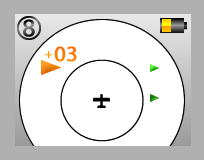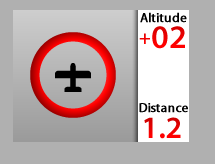
What Nearby Aircraft can PowerFLARM see?
While PowerFLARM will always alert you to the presence of another FLARM-equipped aircraft, PowerFLARM will not see and alert you to all aircraft. The tables below explain when PowerFLARM will see aircraft "X" when X is not equipped with FLARM:
Nearby Aircraft "X" has no FLARM, and... |
PowerFLARM will see... |
| X has ADS-B-Out via 1090-ES operating |  PowerFLARM displays the position of X and alerts you if there's a collision hazard. PowerFLARM displays the position of X and alerts you if there's a collision hazard. |
| X has no transponder nor ADS-B-Out equipment operating | X is invisible to PowerFLARM and you will receive no information about X. |
| X has a transponder operating, and you're not in a radar service area |  PowerFLARM senses the transponder signal strength and warns you if its getting stronger. It can't tell what direction the threat is coming from. It may be able to avoid nuisance alerts depending on the exact information received (depends on how many Mode C/A transponders are nearby whether X's altitude can be distinctly received). PowerFLARM senses the transponder signal strength and warns you if its getting stronger. It can't tell what direction the threat is coming from. It may be able to avoid nuisance alerts depending on the exact information received (depends on how many Mode C/A transponders are nearby whether X's altitude can be distinctly received). |
In a Radar Service Area...
If you have ADS-B-Out via 1090-ES (for example a 1090-ES Trig TT21 transponder attached to a GPS) you'll receive more information inside a radar service area, because ground stations will be aware that you can receive ADS-B-In via 1090 and will send you information about nearby traffic:
Nearby Aircraft "X" has no FLARM,
|
PowerFLARM will see... |
| X has a transponder operating, and you're in a radar service area, |
PowerFLARM will not initially receive TIS-B messages; this function will be added in a software upgrade in late 2011. |
However, if you do not have an ADS-B-Out capability, you'll occasionally get other information via TIS-B:
Nearby Aircraft "X" has no FLARM, you do not have ADSB-Out, and... |
PowerFLARM will see... |
| X has a transponder operating, and you're in a radar service area, and some other aircraft Y near X is known to the ground system to have ADS-B-In capability via 1090 |
This situation is rare, unless you're flying with a buddy who does have ADS-B-Out via 1090. But, even if you don't receive information about X via a TIS-B message, you'll still receive a warning about X's transponder. |


